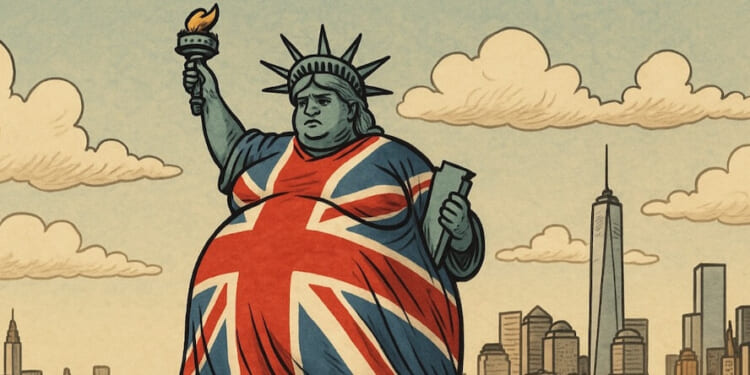Traditionally, the defining moment in a man’s life arrives when he looks in his shaving glass and finds his father staring back at him; but there is a day so much more terrible we rarely speak of it – when he catches himself in a full-length mirror and sees his mother…
-
- Don Paterson, The Book of Shadows
I was living in London when I picked up Paterson’s book of aphorisms. I remember laughing hysterically when I read the passage above, thinking that I had better take care of myself lest I would indeed start to resemble my mother more.
So it is with America and her mother, England.
But instead of widened hips, a big caboose, and a pair of moobs, America has taken on England’s system of debt-financed expansion and run itself into the ground… just like England did.
Debt is the lifeblood of empire — until it becomes the disease.
This sentiment is attributed to David Graeber, an anarchist, anthropologist, and author of the book Debt: The First 5,000 Years. While the exact phrasing isn’t verbatim, the sentiment closely aligns with Graeber’s central thesis about the historical role of debt in shaping empires and social structures.
In reality, a London merchant banker in 1694 or a U.S. Treasury trader in 2025 could’ve uttered that line. Either way, the sentiment holds: credit has powered every great empire… and has ultimately undone it.
While we usually compare America’s trajectory to that of Rome, the British Empire’s timeline is particularly informative when it comes to debt.
Let’s rewind three centuries to where it all began — not in Washington, but in London.
The Birth of Imperial Finance
In 1694, England was broke. King William III was neck-deep in war with France and needed cash fast. Tax revenues couldn’t cover it. So, a syndicate of private investors — the proto–investment bankers of their day — offered him £1.2 million at 8% interest.
In return, the king granted them a royal charter. That group became the Bank of England.
It was the ultimate public-private partnership: private money funding public war. And it created a new economic organism — one that fused state power with private capital.
For the first time, the ability to borrow — not just to tax — became the foundation of national might.
England’s empire, the greatest in history, was built not on gold, but on gilt-edged paper. (British government bonds are called “gilts” because when they were certificated, they had edges gilded with gold.)
The Mechanics of Empire Finance
That initial war loan set a precedent. Soon, public debt financed every naval expedition, colonial conquest, and trade venture.
Credit — not conquest — became the true instrument of power. Every new loan funded ships, troops, or outposts. Each successful war increased national credibility, making future borrowing cheaper.
This self-reinforcing cycle created what historians call the “fiscal-military state.” Debt-fueled war; war justified debt.
And as long as the empire kept expanding, the model worked beautifully. The Bank of England printed the IOUs. The Royal Navy enforced collection. And the colonies provided the returns.
It was a machine — elegant, ruthless, and astonishingly profitable.
From Necessity to Power
By the 18th and 19th centuries, debt had transformed from a desperate wartime necessity into a structural pillar of the empire.
The Bank of England stabilized markets and issued paper money investors around the globe trusted. London became the world’s financial capital. The City financed railways in India, canals in Egypt, mines in South Africa, and revolutions in South America.
British credit was as good as gold — sometimes better.
Debt had become power itself. Paper promises, backed by the credibility of the Crown, financed an industrial revolution. The world’s first central bank had become the engine of global capitalism.
But no machine runs forever.
When the Frontier Closed
By the late 19th century, Britain’s extractive frontier — the outer edge of its empire — began to fade. The Empire had already finished the easy conquests. The colonies were expensive to maintain.
Instead of financing expansion, the debt began to fund maintenance: pensions, bureaucracy, and colonial defense.
The empire had shifted from growth to preservation, from conquest to complacency.
The fiscal machine that once built wealth now merely serviced it. Debt still flowed — but not to build ships or lay railroads. It paid salaries and funded social stability.
The debt that once made Britain strong now made it fragile.
Sound familiar?
The American Parallel
Fast forward to 2025.
The United States stands where Britain stood in 1890: the global hegemon, still powerful, still admired, but visibly overextended.
Since 1945, the U.S. Treasury market has been the world’s ultimate safe haven — the financial backbone of a Pax Americana financed by IOUs.
Treasuries paid for the Cold War, foreign bases, and global trade protection. They funded NASA, Vietnam, Afghanistan, and the dollar’s global dominance.
For decades, foreigners — from the Saudis to the Chinese — willingly lent Washington the funds it used to police the world.
Like the British before them, Americans turned debt into empire.
But here’s the catch: today, U.S. debt no longer finances growth or exploration. It funds maintenance — entitlements, interest payments, and administrative sprawl.
Debt now sustains geopolitics, not productivity. It props up power that can no longer pay for itself.
Structural Weakness in Treasuries
The signs of imperial fatigue are all there.
- Persistent inflation.
- Trillion-dollar deficits.
- Waning foreign demand for Treasuries.
Even Japan — the world’s largest non-U.S. holder — is trimming exposure. China has been quietly dumping Treasuries for years.
The U.S. bond market is beginning to resemble Britain’s late-imperial version: a structure dependent on faith in a government whose reach exceeds its grasp.
As yields rise and deficits balloon, the “risk-free rate” — once the bedrock of global finance — now offers return-free risk.
That’s not just a clever turn of phrase. It’s the precise moment when the bond market stops being an instrument of empire and starts being its obituary.
The Historical Echo
When the world stops sending tribute—sorry, buying Treasuries—the imperial illusion collapses.
In the 19th century, Britain’s global power faded long before its debt did. The pound stayed “strong” until the day it didn’t. Investors still called London the “City” long after New York became the real financial capital.
Credibility always dies last — and suddenly.
The same dynamic is playing out in Washington. The bond market remains enormous, liquid, and seemingly indestructible. But beneath that liquidity lies exhaustion: the fiscal equivalent of imperial overreach.
Both empires — British and American — built their dominance on the same model: issue debt, fund global reach, and let the rest of the world finance your ambitions.
But both discovered that when the world stops believing in the paper, the empire itself is exposed.
From Paper to Tangible Wealth
Every empire eventually runs out of new borrowers.
Britain ran out when its colonies began to industrialize and demand autonomy. The U.S. is running out now, as the BRICS nations build parallel payment systems, central banks hoard gold, and investors seek refuge in hard assets.
The old formula — sell debt, fund dominance — no longer works when nobody wants the debt.
The next era won’t belong to paper promises. It will belong to tangible, productive, hard assets — the very things the empire neglected while it was busy managing its balance sheet.
Gold. Silver. Energy. Real businesses that produce tangible goods.
Empires die by abstraction — by believing that numbers on a screen can replace ships, factories, and fields.
Wrap Up
The Bank of England’s founding was the birth of modern finance. It transformed debt into empire.
Three hundred years later, the same system — now headquartered in Washington — is running out of road.
When debt finances expansion, it’s power. When debt finances survival, it’s decay.
The U.S. Treasury is no longer the engine of growth. It’s the IV drip of a system that’s lost its productive pulse.
Neither London nor DC will write the next chapter of global finance. It’ll be written wherever capital still meets labor, resources, and innovation in the real world.
As investors, our job is simple: get off the sinking ship before the ballast of debt drags it under.
In other words:
Trade paper for metal. Trade promises for proof. Trade empire for independence.
Because history’s final lesson is this — the empire may fall, but value remains.

















